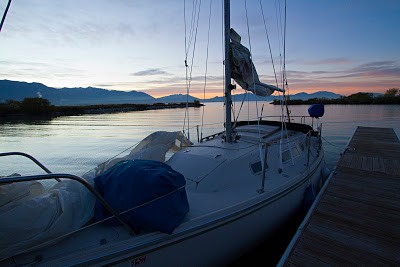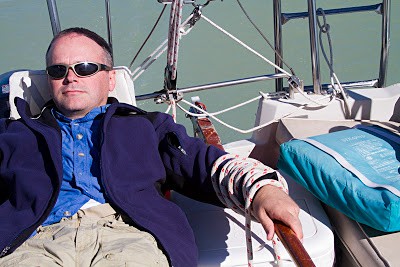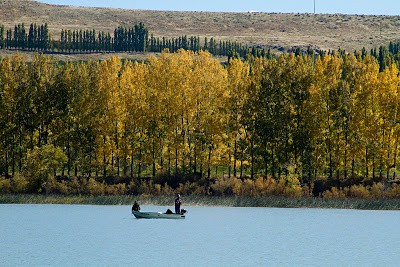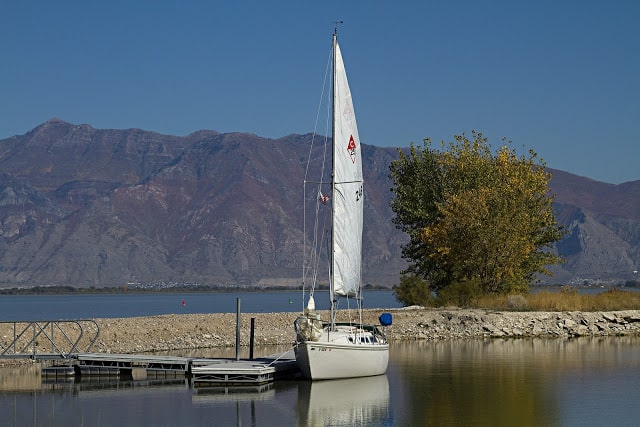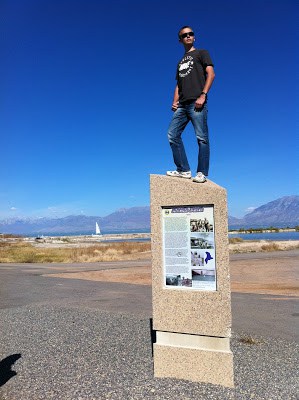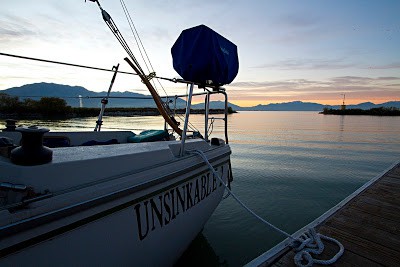
(Click here if you missed day 1 of this sailing adventure.) The fall air is really cool in the morning, and the marina is very quiet. A little too quiet. Oh wait, it’s late October, we’ve already had snow in the mountains. No one is out on the lake this morning!
Nothing will hold my intrepid crew back from day 2 of our epic circumnavigation in our Catalina 25 (of Utah Lake…)
This morning we’re at the northeast-most corner of the lake, preparing to head west. We steel our minds to the rigors of the journey ahead. Doubtless it will be fraught with perilous light winds, the lure of exotic ports, and hardscrabble subsistence on the ship’s supply of beef jerky, m&ms, licorice, and cooler full of bottled drinks. Lesser men (and women) would feign attempt such a journey.
Eventually a couple comes down to fish from the docks, spending more time watching us get ready to set sail than actually fishing. It was pretty warm in the boat last night. The external temperature dropped into the 30s this morning, but the boat was warm with light sleeping bags. A big part of staying warm is just staying out of the wind. A truth not exactly congruent with sailing.
The wind will pick up this morning as the sun starts to peek over the mountains, sending strong breezes down the canyons. We decide to hurry and get underway so we can catch all available wind. The forecast is calling for fairly settled conditions later in the day, and we have a long way to go. Breakfast consists of granola bars and apples so we don’t have to cook.
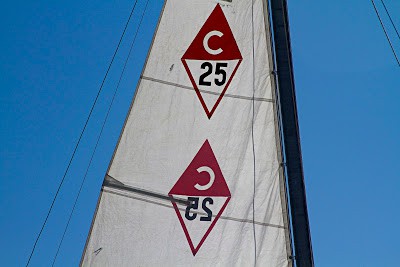 Soon the canyon breeze kicks in from directly astern. This is a fun point of sail called “wing and wing” sailing. Basically, you want one sail out on one side of the boat, and the other out the other side to catch every puff of wind available. So we pull the boom far out to starboard and pole out the genoa to port. We’re making good time now, but we realize that as soon as the canyon breeze is over, its going to be a slow day.
Soon the canyon breeze kicks in from directly astern. This is a fun point of sail called “wing and wing” sailing. Basically, you want one sail out on one side of the boat, and the other out the other side to catch every puff of wind available. So we pull the boom far out to starboard and pole out the genoa to port. We’re making good time now, but we realize that as soon as the canyon breeze is over, its going to be a slow day.
The boat moves along nicely for a couple miles, and its starting to warm up. I’d better go down below and shed the polypro base layer I wore overnight so that I don’t start smoldering.
That’s when the unthinkable happened aboard the unsinkable. The sails fluttered. I felt the floor of the cabin go from slightly-tilted-forward to level. The canyon winds were done.
Becalmed. An eerie calm sets over the crew now. As captain, I grow concerned, knowing that in sailing history there were many examples of crews going nearly crazy after days and weeks of sitting idly in the middle of the ocean with no wind. Restless, and with dwindling supplies, the crews would eventually blame one of their own for the misfortune, and sacrifice them to whatever beings they thought would listen. I was determined not to see that happen on my boat.
But then again, history also records a certain Iphigenia, the daughter of Agamemnon in ancient Greece. Sailing to the Trojan War, the Greek fleet found itself becalmed at Aulis. The only way to sail on was for Agamemnon to sacrifice Iphigenia to Artemis. We’re all thinking about it, but no one says it, at first. And then Zack says to Kate, “would you hand me another gatorade, Iphigenia?”
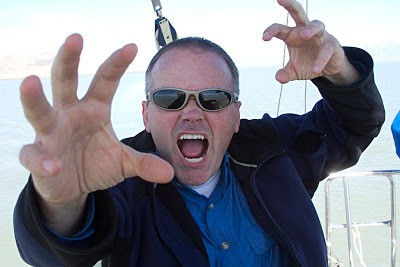 The rest is a blur to me. And the mad scribblings in my logbook are nigh unintelligible. Kate tells us that she had to barricade herself in the forward cabin because Zack and I started calling her Iphigenia more and more, and soon we were gathering the wood on the boat to build a sacrificial fire. I wouldn’t believe it, except Kate managed to snap the following picture of her loving father and captain at some point. Near as I can tell, it isn’t photoshopped. Things must have been bad out there in the doldrums.
The rest is a blur to me. And the mad scribblings in my logbook are nigh unintelligible. Kate tells us that she had to barricade herself in the forward cabin because Zack and I started calling her Iphigenia more and more, and soon we were gathering the wood on the boat to build a sacrificial fire. I wouldn’t believe it, except Kate managed to snap the following picture of her loving father and captain at some point. Near as I can tell, it isn’t photoshopped. Things must have been bad out there in the doldrums.
Fortunately, Iphigenia had the presence of mind to slip to the back of the boat and raise the one sail that could get us out of this predicament. The Iron Genny. Kate probably owes her life to the skilled sailmakers over at Tohatsu. Finally underway again, Zack and I were able to return to our senses and continue the voyage to Saratoga Springs.
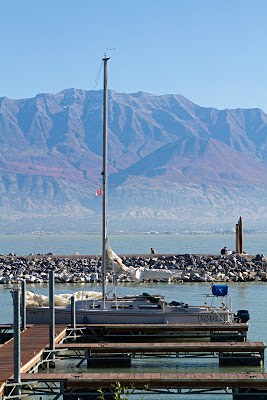 Eventually we made landfall at the Pelican Point Harbor. It’s obvious people don’t see sailboats here very often. They are lined up along the jetty walls fishing and everyone stops to watch us pull into the harbor and tie off. There’s something about an audience, a sailboat, and our egos that combine to inspire a little more flare in our docking skills. Zack and Kate leap from the boat to the dock, dock lines trailing expertly in the air behind them as they fly. Even my grip on the tiller seems more showman-like. We must demonstrate with every action the seamanship and nautical prowess that brought our ancestors across the Atlantic only 300 years ago. Their salt runs in our veins.
Eventually we made landfall at the Pelican Point Harbor. It’s obvious people don’t see sailboats here very often. They are lined up along the jetty walls fishing and everyone stops to watch us pull into the harbor and tie off. There’s something about an audience, a sailboat, and our egos that combine to inspire a little more flare in our docking skills. Zack and Kate leap from the boat to the dock, dock lines trailing expertly in the air behind them as they fly. Even my grip on the tiller seems more showman-like. We must demonstrate with every action the seamanship and nautical prowess that brought our ancestors across the Atlantic only 300 years ago. Their salt runs in our veins.
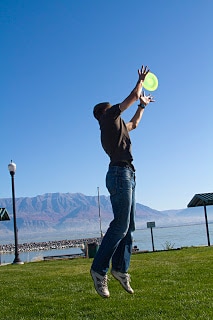 There are beautiful homes along the lake here, with fantastic views of Mount Timpanogos and the lake. The neighborhoods along the lake all boast nautically-themed street names and homes positioned to take in the lake’s scenic views.
There are beautiful homes along the lake here, with fantastic views of Mount Timpanogos and the lake. The neighborhoods along the lake all boast nautically-themed street names and homes positioned to take in the lake’s scenic views.
Utah Lake was the gathering place for Native American tribes long before settlers came to the valley. Tribes would come to the provo river each year as the fish would spawn to catch and dry fish, trade, and hunt along the lake’s fertile shores. The lake was originally called “Lake Timpanogos”, a name that I would like to see return.
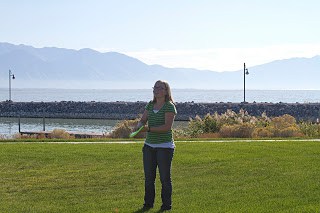 It’s mid morning now and we decide we need some exercise. Luckily Zack brought a frisbee. Actually, it’s probably not that lucky, because Zack is several inches taller than Kate and me, and his armspan is 3 inches longer than his height. We don’t stand a chance at beating Zack. But it’s a beautiful sunny day, and so the ultimate frisbee begins. The exercise feels great, and the temperature is warm enough now that we shed our jackets and spend an hour running, throwing, and diving. The light breeze is perfect for frisbee.
It’s mid morning now and we decide we need some exercise. Luckily Zack brought a frisbee. Actually, it’s probably not that lucky, because Zack is several inches taller than Kate and me, and his armspan is 3 inches longer than his height. We don’t stand a chance at beating Zack. But it’s a beautiful sunny day, and so the ultimate frisbee begins. The exercise feels great, and the temperature is warm enough now that we shed our jackets and spend an hour running, throwing, and diving. The light breeze is perfect for frisbee.
Eventually, we decide to get sailing again. We have the longest stretch of the voyage ahead, and with little to no wind it will be a long sail to Lincoln Beach on the south end of Utah Lake.
Such austere sailing conditions will require drastic measures. So I order the crew to lash me to the tiller, just as a helmsman would have been lashed to the wheel while rounding the Horn in the Age of Sail. Only in my case it was to keep the boat on course in case I fell asleep, not to prevent the helmsman from being swept overboard.
Utah Lake is 10-12 feet deep. The advantage of being shallow is that the lake heats up quickly in the spring and stays comfortably warm all summer. The down side is that even moderate windstorms can kick up fairly large waves which are problematic for low-slung powerboats and fishing boats, but actually provide a rather thrilling ride from the safety of a sailboat. This tendency to build waves quickly provides a nice balance between the power boaters and sailors on the lake. When the wind and waves pick up, the power boaters come in and the sailors set sail.
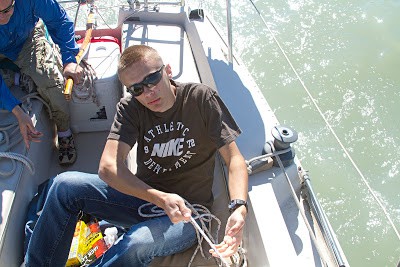 With little wind today, that doesn’t really seem to make a difference though. Still, we sail on. There are many important life lessons learned while sailing. Sublime truths that are only available to those who dare cast off from the safety of shore and sail out into the unknown, carried by the winds and seas to discover the lessons of life known only to farers of the sea. Sailing along all these hours, straining to adjust the sails and make maximum use out of every slight puff of light air, my son Zack uttered the following newly-formulated moral:
With little wind today, that doesn’t really seem to make a difference though. Still, we sail on. There are many important life lessons learned while sailing. Sublime truths that are only available to those who dare cast off from the safety of shore and sail out into the unknown, carried by the winds and seas to discover the lessons of life known only to farers of the sea. Sailing along all these hours, straining to adjust the sails and make maximum use out of every slight puff of light air, my son Zack uttered the following newly-formulated moral:
“Sometimes it’s more important to go fast, than to get where you’re trying to go.”
Truer words were never spoken. I just hope he doesn’t take himself too seriously.
After passing Pelican Point, a small Peninsula jutting out from the lake’s western shore, we settle in for the long voyage south. With the exception of Pelican Point’s moderate protection, there are no natural safe harbors on the lake. We sail on, watching the distant orchards on the lake’s south shore slowly get bigger. There are several fishermen out this afternoon along the shore, I am struck with the brilliant idea of sailing in as close to the shore as we can. I’m not sure if it was the humidity or the psychology of the sailor in light air, but that was my brilliant idea. About 200 fee from shore, we ran aground.
Running aground in a sailboat is the start of many humorous and sometimes tragic stories. But not about the Catalina 25, Unsinkable 2. This boat is a swing keel, which means that the 1700 lbs. keel can be raised and lowered with a winch in the boat. So when we run aground, some aboard simply raises the keel a few cranks, and we sail off into deeper water.
Around the corner from the orchards, we finally reach Lincoln Beach Harbor. Lincoln Beach has several hot springs, and at different times has been developed into a resort. Now it consists of a small harbor with picnic tables, restrooms, and a historical marker. There is just one small dock in the harbor, intended for loading and unloading fishing passengers.
We’ve just about completed the circumnavigation. The sail north back to Provo Harbor will take a few hours. Our original plan had included a stop at Bird island, but with the high water this year, the island is completely submerged.
Doubtless, they will be raising a monument in honor of our historical circumnavigation these past 24 hours. Until they do, this picture will have to suffice. Zack stands triumphantly atop the concrete Lincoln Beach historical marker, with the trusty Unsinkable 2 waiting faithfully at the dock in the background.
We’ll make this circumnavigation an annual festivity, hopefully on a weekend with a little more wind next year.

